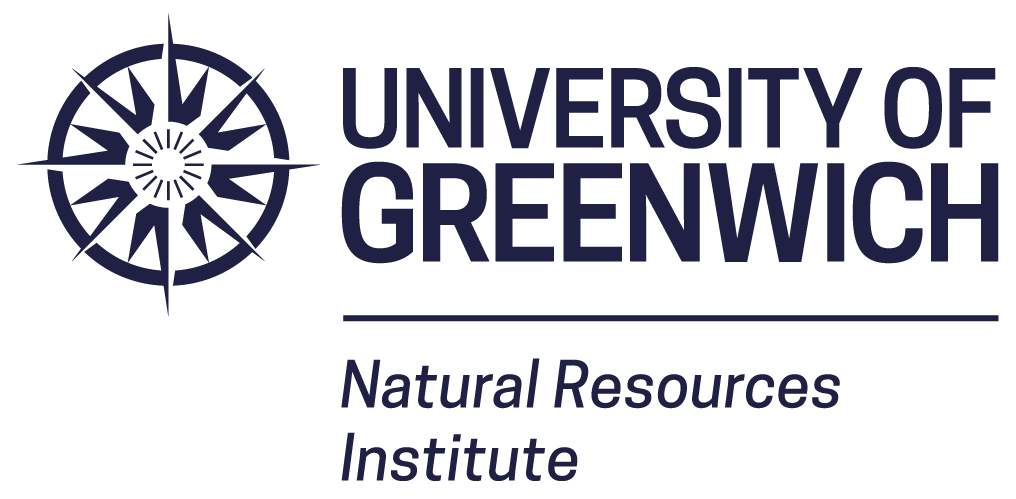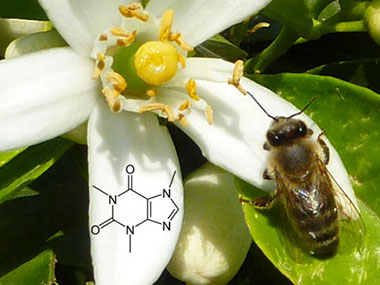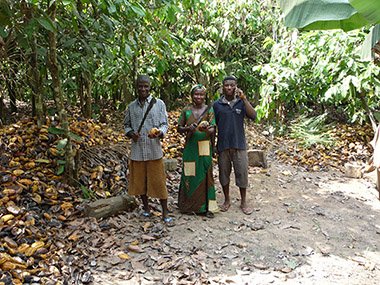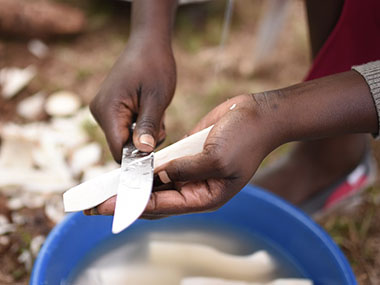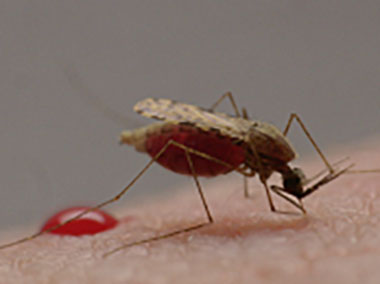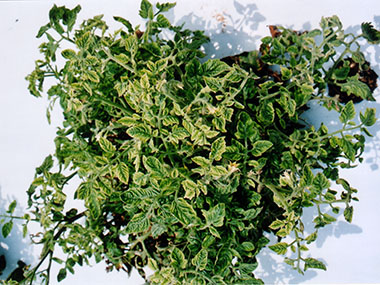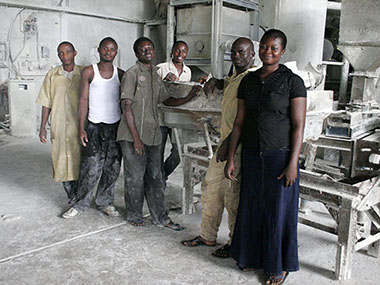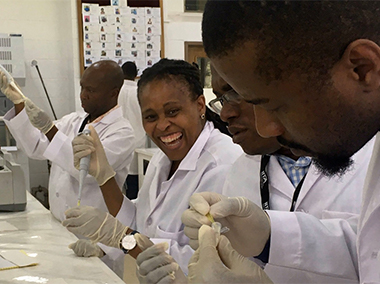Chemical Ecology and Plant Biochemistry

Chemical Ecology is the study of naturally occurring compounds that mediate the interactions of organisms with each other and with their surroundings. Understanding these interactions can lead to the discovery of novel methods for controlling pest and disease organisms and optimising the behaviour of beneficial insects and pollinators without harmful effects on the environment.
Our Group has an international reputation for fundamental and applied research in Chemical Ecology, established during more than 50 years of work, primarily in developing countries but also in the UK and mainland Europe. The Group has world renowned expertise in the isolation, identification, synthesis, formulation and applications of natural products from plants and animals.
These natural products include pheromones and other attractants for monitoring and control of crop and storage pests, host attractants for monitoring and control of disease vectors, chemicals responsible for resistance of crops to pests and pathogens and plant compounds that mediate the health, behaviour and well-being of pollinators.
The Group includes specialists in chemistry, entomology and plant biochemistry, and we work with a wide range of collaborating organisations and industrial partners in the UK, Europe and developing countries. Although focussed on providing solutions to problems in pest and disease management, members of the Group lecture and publish widely and are long-standing members of the international chemical ecology community.
- Exploitation of interspecific signals to deter oviposition by spotted-wing drosophila BBSRC BB/S005641/1 (2019-2022)
- Monitoring the canola flower midge with pheromones: Canola Agricultural Research Program (2020-2022)
- RODENTGATE Future rodent management for pig and poultry health ERA-NET (2021-2024)
- Novel trapping systems for monitoring and control of Hylobius abietis, Forestry and Land Scotland (2019-2021)
- Developing prototype Volatile Organic Compound sensor-based products for determining soil health on-farm, Innovate UK 31793 (2019-2022).
- Identification of the sex pheromone of Nesidiocoris tenuis, a damaging pest of commercial tomato AHDB/BBSRC (2019-2020)
- Heather Beetle Control, UoG Seedling Fund and UK Heather Trust (2020-2021)
- Are pollen sterols landscape limiting nutrients for bees in the UK NERC-UKRI NE/V021583/1 (2021-2024 PCS @Kew)
- Africa AgriFood Knowledge Transfer Partnership - Commercial opportunities for Croton megalocarpus (KTP1245) (2022-2023)
- Influence of diet on honeybee lipidome BBSRC-UKRI BB/T014210/1 PCS @Kew (2020-2023)
- Pyrethrum in Bloom: Agritech Catalyst 9 Innovate UK TS/V000934/1 (2020-2023)
- Farmer Research Network Assessments of Botanical Pesticides to Augment Above and Below Ground Ecosystem Services for Crop Resilience, McKnight Foundation. Collaborative Crops Research Program (Ref 20-034)
- Scoping innovations for improved strawberry pollination by commercial bumblebees using caffeine BBSRC-UKRI (BB/T003960/1) 2019
- Realising the potential of bioresources to mitigate development challenges in Ethiopia, EPSRC (EP/T024925/1) 2020
- Natural Pest Regulation in Orphan Crop Legumes in Africa (BBSRC-GCRF-SASSA) (2018-2021) (more…)
- Environmentally Benign Combination Biopesticides - Transforming Pest Control in Chinese and UK Agriculture (Innovate UK -Agritech-Newton) (2019-2022)
- Farmer research networks to evaluate sustainable agro-ecological crop protection using pesticidal plants (McKnight Foundation) (2017-2020) (more…)
- Innovation For Improved Strawberry Pollination By Commercial Bumblebees Using Caffeine (BBSRC-IPA) (2017-2019) (more…)
- The Dengue Vector Aedes aegypti: Microbiota and the Chemical Ecology of Oviposition Sites (MRC: 2016-2019)
- Exploitation of interspecific signals to deter oviposition by spotted-wing drosophila (BBSRC; 2019-2022)
- Auto-dissemination of Entomopathogenic Fungi for Sustainable Control of Spotted Wing Drosophila (Innovate UK; 2018-2021)
- Identification of the sex pheromone of the newly-discovered Contarinia sp. near nastrutii (CARP; 2017-2020)
- Development of a push-pull strategy against spotted wing drosophila (BBSRC-CTP, 2017-2021)
- A semiochemical based strategy for control of red poultry mite (BEMB; 2018-2022).
- Oviposition behaviour of Aedes aegypti (DTA 2017-2020)
- IPM of Tree Fruit Pests and Diseases (AHDB; 2015-2020)
- IPM of Strawberry Pests (AHDB; 2015-2020)
- Understanding and developing methods for managing spotted wing drosophila (SWD) in the UK (AHDB; 2015-2020)
- Reducing Contamination of Groundwater by Pesticides in Brazil (Innovate Newton; 2016-2019)
- Biochemistry based selection and development of nutrient rich, weevil resistant sweet potato varieties in Uganda (Bill and Melinda Gates Foundation) (2014-2018)
- CocoaPOP: Cocoa Pollination for Optimised Production (EC-Africa Caribbean Pacific Science and Technology Programme) (2013-2017). (More…)
- Application of General Repellents Against Agricultural Pests (2016-2017)
- Early Attractants for the Major New Fruit Dropsophilia suzukii, a Super Lure (2016-2017)
- Harnessing Agricultural Ecosystem Biodiversity in small holder farming (Darwin Initiative) (2015-2017) (more…)
- OPTIONS, Optimising Pesticidal Plants: Technology Innovation Outreach and Networks (EC-Africa Caribbean Pacific Science and Technology Programme)(2013-2017) (more…)
- Medicine or poison? Consequences of floral chemistry and bee pathogens for bee performance and pollination (2013-2017)
- New biofumigation-based approaches to sustainable control of soil-borne pathogens (2011-2015) (more...)
- Toxic nectar and pollen: impacts on flower-visiting mutualists and antagonists and the role of invasion success (2011-2014)
- Development of improved methods for detection, control and eradication of pine wood nematode in support of EU Plant Health policy (2011-2014) (more...)
- Sex Pheromone Trap for Blackberry Leaf Midge (2010-2012) (more...)
- Improved pest and disease management in blackcurrant (2010-2015) (more...)
- African Dryland Alliance for Pesticidal Plant Technologies: A network for optimising and promoting the use of indigenous botanical knowledge for food security and poverty alleviation in Africa (2010-2013) (more…)
- Biocontrol & Selective Physical Controls in Integrated Management of Pear Sucker (2008-2012) (more....)
- Safe control of mirid pests on cocoa in West Africa (2007-2011) (more....)
- Pheromone Technology for Management of Capsid Pests to Reduce Pesticide Use in Horticultural Crops (2007-2010) (more...)
- The Southern Africa Pesticidal Plants Project (SAPP): Caesalpinioid Woodlands of Southern Africa: Optimising the Indigenous Use of Pesticidal Plants (2007-2011)
- Integrated Pest and Disease Management for high quality protected raspberry production (2006-2011) (more...)
- Biofumigant crops as replacements for methyl bromide soil sterilisation in sustainable strawberry production (2006-2010) (more...)
- The chemical diversity of midge pheromones (2006-2009) (more...)
- Tsetse.org - all you need to know about tsetse but were afraid to ask.
Current PhD students
- Elisante Philemon: Agroecosystem biodiversity for harnessing pollination services in bean farming systems (NMAIST, Arusha)
- Prisila Mkenda: Agroecosystem biodiversity for harnessing natural pest regulation services in bean farming systems (NMAIST, Arusha)
- Jillian Joiner: Ecology of Aedes mosquito
- Christina Conroy: Push-pull against Spotted Wing Drosophila
- Richard Lloyd Mills: Control of red poultry mite
- Arran Folly: Health benefits to pollinators from nectar and pollen chemistry of UK Agri-environment Scheme plants (Royal Holloway University of London)
- Laura Haynes: Impacts of Novel Multimodal Biopesticides on Beneficial Insects
- Cormac Creagh: The role of vector competence in the transmission of Cacao Swollen Shoot Virus
Recently Completed PhD students
- Billy Ferrara: Investigating MATE transporters in Dictyostelium discoideum: 2018
- Milton Otema: Resistance in Sweetpotato to Cylas weevils 2015
- Aliyu Aminu: Interactive effects of chickpea leaf surface chemicals and NPV 2015
- John Kamanula: Pesticidal plants for controlling stored product pests 2015
- Stephen Nyirenda: Pesticidal plants for controlling mites and aphids 2015
- Professor Philip Stevenson
Professor of Plant Chemistry. Over 30 years of experience studying the chemistry of plants and determining their biological activities. Interests in plant pesticides in resource-poor farming in Africa, resistance mechanisms to insects and diseases in crops (e.g., sweetpotato, groundnuts, chickpea, rice) and pollination ecology and bee health. Current funding sources include BBSRC, GCRF, Newton-Innovate UK, European Union (ACP S&T) and McKnight Foundation. Holds position at Royal Botanic Gardens, Kew. Extensive field experience in South Asia and Africa. - Professor David Hall
Professor of Chemical Ecology. Natural products chemist with over 40 years of experience in isolation, identification, synthesis, formulation and field application of insect semiochemicals and other natural products for monitoring and control of insect pests and diseases. Extensive short-term overseas experience in Asia, Africa and South America. Currently working on pests of cotton, coffee and cocoa in developing countries, and horticultural and forest pests in UK and the rest of Europe. Author of over 200 peer-reviewed publications. - Dr Daniel Bray
Senior Research Fellow in Chemical Ecology. A behavioural ecologist with 15 years of experience working in chemical ecology. Extensive field work in Brazil developing pheromone based tools for control of leishmaniasis. Leads current projects on spotted wing drosophila and Aedes aegypti, which combine electrophysiology studies, lab bioassays, and field trials. Experience of working with insect, mammalian and marine systems. - Dr G Mandela Fernandez-Grandon
Research Fellow in Chemical Ecology/Entomology. A decade of experience working with crop pests and vectors of human diseases. Expertise in insect behavioural studies and electrophysiology. Particular areas of interest include the development of novel odour-based control methods for crop protection and the study of host manipulation by viruses/parasites and the potential for application. Current research projects include evaluating mosquito oviposition preference (MRC funded), evaluating the feasibility of a broad spectrum repellent (Agritech) and development of a new attractant lure for Spotted Wing Drosophila (Agritech). - Dudley Farman
Analytical chemist with over 18 years of experience in analysis and formulation of insect pheromones and related natural products, and also in chemical quality assessment of horticultural produce. Wide experience of installation and maintenance of computer hardware and software, and of analytical equipment. Short-term overseas experience in Africa. - Dr Steve Harte
Postdoctoral Organic Chemist/Chemical Ecologist with over 5 years of experience of working as a natural product chemist identifying and purifying novel fungal secondary metabolites used as part of a novel drug discovery methodology. Whilst at the NRI Steven has worked with the identification, isolation and synthesis of semio-chemicals collected from a variety of natural sources. Current projects include development of a pheromone-based monitoring system for a newly identified Contarinia midge, identification of weevil resistant sweetpotato varieties and upcycling of brewery waste to produce cosmetically active compounds. - Victoria Woolley
Post Doctoral Research Fellow working on the NaPROCLA project (BBSRC-GCRF-SASSA). Previous research has focused on elucidating the natural function of entomopathogenic fungal secondary metabolites and identifying their potential for integrated pest management. The current project involves using a combination of molecular biology techniques and field trials, to investigate the potential of natural enemies to control insect pests of legumes in east Africa.
Affiliates
Upcoming:
- J. Li, J. Lin, G. M. Fernández-Grandon, M. You, X. Xia (Accepted) Functional identification of C-type lectin in the diamondback moth, Plutella xylostella (L.) innate immunity, Journal of Integrative Agriculture.
- Barbosa, V.A., de Souza, C.F., Pereira, A., Gatherer, D. Brazil, R., Bray, D.P., & Hamilton. J.G.C. (Accepted) Insecticide-impregnated netting: a surface treatment for killing Lutzomyia longipalpis the vector of Leishmania infantum. Current Research in Parasitology & Vector-Borne Diseases
- Hall D.R., Harte S.J., Farman D.I., Ero M, Pokana A. (In review) Aggregation Pheromone of the Guam Strain of Coconut Rhinoceros Beetle, Oryctes rhinoceros, and Revision of Stereochemistry, Journal of Chemical Ecology.
2021
- Arnold, SEJ, Dudenhöffer, J, Fountain, MT, James, KL., Hall, DR, Farman, DI, Wäckers, F & Stevenson, PC. (2021) Bumble bees show an induced preference for flowers when primed with caffeinated nectar and a target floral odour. Current Biology (In press)
- Arnold, S.E.J., Elisante, F., Mkenda, P.A., Tembo, Y., Ndakidemi, P.A., Gurr, G.M., Darbyshire, I., Belmain S.R., Stevenson P.C. (2021) Trees with benefits: Linking botanical diversity with ecosystem service providers in farmlands. Scientific Reports 11: 15190.
- Anyanga, M.O., Farman D.I., Ssemakula, G.N., Mwanga, R.O.M., Stevenson P.C. (2021) Effects of hydroxycinnamic acid esters on sweetpotato weevil feeding and oviposition and interactions with Bacillus thuringiensis toxin, Journal of Pest Science. 94: 783–794.
- Bartley, K., Chen, W., Lloyd Mills, R.I. et al. (2021). Transcriptomic analysis of the poultry red mite, Dermanyssus gallinae, across all stages of the lifecycle. BMC Genomics 22, 248.
- Folly, A., Koch, H., Stevenson PC and Brown MJF. (2021) Agri-environment nectar chemistry supresses parasite social epidemiology in an important pollinator. Proceedings of the Royal Society: B. 288: 20210363
- Hall, D.R., Harte, S.J., Bray, D.P., Farman, D.I. James, R., Silva, C.X., Fountain, M.T. (2021). Hero turned villain: Identification of components of the sex pheromone of the tomato bug, Nesidiocoris tenuis. Journal of Chemical Ecology, 47, 395-405.
- Hafeez, M., … Fernández-Grandon, G.M. and Zalucki, M.P. (2021) De novo transcriptomic analyses revealed some detoxification genes and related pathways responsive to noposion yihaogong® 5% EC (Lambda-Cyhalothrin 5%) exposure in Spodoptera frugiperda third-instar larvae. Insects, 12(2), p.132.
- Hafeez, M.… Wang, L. and Fernández-Grandon, G.M… (2021) Sublethal effects of bistrifluron on key biological traits, macronutrients contents and vitellogenin (SeVg) expression in Spodoptera exigua (Hübner). Pesticide Biochemistry and Physiology, p.104802.
- Hafeez, M., … Fernández‐Grandon, G.M. and Lu, Y.B. (2021) Role of digestive protease enzymes and related genes in host plant adaptation of a polyphagous pest, Spodoptera frugiperda. Insect Science. 28, 611-626.
- Li, X.W., … Fernández-Grandon, G.M. and Lu, Y.B. (2021) Intercropping rosemary (Rosmarinus officinalis) with sweet pepper (Capsicum annum) reduces major pest population densities without impacting natural enemy populations. Insects, 12(1), p.74.
- Mvumi, B.M., Nyahangare, ET, Eloff, JN, Belmain, SR, Stevenson, PC, (2021). Cattle tick control in Africa: challenges with synthetic acaricides and potential of ethnoveterinary plants. CAB Reviews 16, No. 042
- Zu, P., Koch, H., Schwery, O., Pironon, S., Phillips, C., Ondo, I., Farrell, I.W., Nes, W.D., Moore, E., Wright, G.A., Farman, D.I., Stevenson P.C. (2021) Pollen sterols are associated with phylogenetics and environment but not with pollinators New Phytologist, 230, 1169-1184.
- Fountain MT, Deakin G, Farman DI, Hall DR, Jay C, Shaw B, Walker A. (2021) An effective “push-pull” control strategy for European tarnished plant bug, Lygus rugulipennis (Heteroptera: Miridae), in strawberry using synthetic semiochemicals. Pest Management Science, 77:2747-2755.
2020
- Adler, LS, Fowler, AE, Malfi, RL, Anderson, PR, Coppinger, LM, Deneen, PM, Lopez, S, Irwin, RE, Stevenson, PC. (2020). Assessing Chemical Mechanisms Underlying Effects of Sunflower. Journal of Chemical Ecology 46, 649-658.
- Aguirre, L.A., Davis, J.K., Stevenson P.C., Adler, L.S. (2020). Herbivory and Time Since Flowering Shape Floral Rewards and Pollinator-Pathogen Interactions. Journal of Chemical Ecology, 46, 978-986.
- Amoabeng, B., Stevenson, P.C., Mochiah, B., Asare, K.P., Gurr, G.M. (2020) Scope for non-crop plants to promote conservation biological control of crop pests and serve as sources of botanical insecticides. Scientific Reports, 10, 6951.
- Borrell J.S., Dodsworth S., Forest, F., Perez-Escobar O., Lee M. A., Mattana E., Pritchard H., Ballesteros D., Stevenson P.C., Howes M.-J.R., Kusumoto B., Ondo I., Milliken, W., Moat J., Ryan P., Ulian T., Pironon S (2020). The climatic challenge: Which plants will people use in the next century? Environmental and Experimental Botany, 170 e103872
- Elisante, P. Ndakidemi, P.A., Arnold, S.E.J., Belmain, S.R., Gurr, G.M., Darbyshire, I., Xie G. and Stevenson, P.C. (2020) Insect Pollination Is Important But Not Limiting In A Smallholder Bean-Farming System. PeerJ. 8: e10102.
- Fernández-Grandon, G.M., Harte, S.J., Ewany, J., Bray, D. and Stevenson, P.C. (2020) Additive effect of botanical insecticide and entomopathogenic fungi on pest mortality and the behavioral response of its natural enemy. Plants, 9(2), p.173.
- Folly, AJ, Stevenson P.C., Brown, M.F.J. (2020). Age-related pharmacodynamics in a bumblebee-microsporidian system mirror similar patterns in vertebrates. Journal of Experimental Biology, 223, jeb217828.
- Hafeez, M., … Fernández-Grandon, G.M., Li, X., Gulzar, A., Ali, B., Rehman, M. and Ali, S. (2020). RNA interference-mediated knockdown of a cytochrome P450 gene enhanced the toxicity of α-cypermethrin in xanthotoxin-fed larvae of Spodoptera exigua (Hübner). Pesticide biochemistry and physiology, 162, pp.6-14.
- Harris, S.J., Bray, D.P., Adamek, M., Hulse, D.R., Steinhagen, D., Hoole, D. (2020). Effect of β-1/3,1/6-glucan upon immune responses and bacteria in the gut of healthy common carp (Cyprinus carpio). Journal of Fish Biology, 96, 444-455.
- Mkindi. AG., Tembo, YLB, Mbega, ER, Smith AK, Farrell IW, Ndakidemi, PA, Stevenson, PC, and Belmain SR, (2020). Extracts of Common Pesticidal Plants Increase Plant Growth and Yield in Common Bean Plants, Plants, 9, e149.
- Mkenda, P.A. Ndakidemi, P.A., Stevenson, P.C., Arnold. SEJ, Darbyshire, I., Belmain, S.R., Priebe, J., Xie, G. Johnson, A.C., Tumbo, J., Gurr, G.M. (2020). Knowledge gaps among smallholder farmers hinder adoption of conservation biological control. Biocontrol Science and Technology, 30 (3), 256-277.
- Spanoudis, C.G., Andreadis, S.S., Bray, D.P., Savopoulou-Soultani, M., Ignell, R. (2020). Behavioural response of the house mosquitoes Culex quinquefasciatus and Culex pipiens molestus to avian odours and its reliance on carbon dioxide. Medical and Veterinary Entomology, 34, 129-137.
- Stevenson et al., (2020). State of the World’s Urban Ecosystems: what can we learn from trees, fungi and bees? Plants, People, Planet. 2, 482-498.
- Stevenson P.C. (2020). For antagonists and mutualists: the paradox of insect toxic secondary metabolites in nectar and pollen. Phytochemistry Reviews, 19, 603-614.
- Phambala, K. Tembo, Y., Kasambala, T., Kabambe, VH, Stevenson P.C., Belmain, S.R., (2020). Bioactivity of common pesticidal plants on fall armyworm larvae (Spodoptera frugiperda) Plants 9, e112.
- Rioba N. and Stevenson, P.C., (2020). Opportunities and Scope for Botanical Extracts and Products for the Management of Fall Armyworm (Spodoptera frugiperda) for Smallholders in Africa. Plants, 9, e207.
- Woolley, V. C., Teakle, G. R., Prince, G., de Moor, C. H., & Chandler, D. (2020). Cordycepin, a metabolite of Cordyceps militaris, reduces immune-related gene expression in insects. Journal of Invertebrate Pathology, 177, 107480.
- Zu P, Boege, K., del-Val, E., Schuman, M.C., Stevenson, P.C., Zaldivar-Riveron, A., Saavedra, S. (2020) Information arms race explains plant-herbivore chemical communication in ecological communities, Science, 368, 1377-1381.
- Mozūraitis R, Hall DR, Trandem N, Ralle B, Sigsgaard L, Baroffio C, Fountain M, Cross J, Wibe A, Borg-Karlson A-K (2020) Composition of strawberry floral volatiles and their effects on behavior of strawberry blossom weevil, Anthonomus rubi. J Chem Ecol 46:1069–1081 https://doi.org/10.1007/s10886-020-01221-2
- Lord JS, Lea RS, Allan FK, Byamungu M, Hall DR, Lingley J, Mramba F, Paxton E, Vale GA, Hargrove JW, Morrison LJ, Torr SJ, Auty HK. (2020) Assessing the effect of insecticide-treated cattle on tsetse abundance and trypanosome transmission at the wildlife-livestock interface in Serengeti, Tanzania. PLOS Neglected Tropical Diseases | https://doi.org/10.1371/journal.pntd.0008288 August 25 ,2020
- Sarfo JE, Campbell, CAM and Hall DR. (2020) Effect of sex pheromone blend and lure age on trap catches of cacao mirids in Ghana. Crop Protection https://doi.org/10.1016/j.cropro.2020.105344
- Kihika R, Tchouassi D, Ng'ang'a M, Hall DR, Beck J, Torto B (2020) Compounds associated with infection by root-knot nematodes influence the ability of infective juveniles to recognize host plants. J Agric Food Chem DOI: 10.1021/acs.jafc.0c03386
- Mahot H.C., Mahob R.J., Hall D.R., Arnold S.E.J., Fotso K.A., Membang, G., Ewane, N., Kemga, A., Fiaboe, K.K.M., Bilong B.C.F., Hanna R. (2020) Visual cues from different trap colours affect catches of Sahlbergella singularis (Hemiptera: Miridae) in sex pheromone traps in Cameroon coco plantations. Crop Protection: 127: 104959 https://doi.org/10.1016/j.cropro.2019.104959
2019
- Arnold, S.E.J., Forbes, S.J., Hall, D.R., Farman, D.I., Bridgemohan, P., Spinelli, G.R., Bray, D.P., Perry, G.B., Grey, L., Belmain, S.R., Stevenson, P.C. (2019) Floral Odors and the Interaction between Pollinating Ceratopogonid Midges and Cacao. Journal of Chemical Ecology, 45, 869-878.
- Courtenay, O., Dilger, E., Calvo-Bado, L.A., Kravar-Garde, L., Carter, V., Bell, M.J., Alves, G.B., Goncalves, R., Makhdoomi, M.M., González, M.A., Nunes, C.M., Bray, D.P., Brazil, R.P., Hamilton, J.G.C. (2019). Sand fly synthetic sex-aggregation pheromone co-located with insecticide reduces the incidence of infection in the canine reservoir of visceral leishmaniasis: A stratified cluster randomised trial. PLoS Neglected Tropical Diseases, 13, e0007767.
- Davis, J.K, Aguirre, L.A., Barber, N.A, Stevenson, P.C. and Adler, L.S., (2019). From plant fungi to bee parasites: mycorrhizae and soil nutrients shape floral chemistry and bee pathogens. Ecology 100, e 02802.
- Elisante, F. Ndakidemi, P.A., Arnold, S.E.J., Belmain, S.R., Gurr, G.M., Darbyshire, I., Xie, G., Tumbo, J., and Stevenson, P.C. (2019) Knowledge Gaps on The Role Of Pollinators And Value Of Field Margins Among Smallholders In Bean Agri-Systems, Journal or Rural Studies, 70, 75-86
- Hafeez, M., … Fernández‐Grandon, G.M., Nawaz, M., Ahmad, A. and Wang, M. (2019) Gossypol‐induced fitness gain and increased resistance to deltamethrin in beet armyworm, Spodoptera exigua (Hübner). Pest Management Science, 75(3), pp.683-693.
- Hafeez, M., Liu, S., Jan, S., Gulzar, A., Fernández-Grandon, G.M., Qasim, M., Khan, K.A., Ali, B., Kedir, S.J., Fahad, M. and Wang, M. (2019) Enhanced effects of dietary tannic acid with chlorantraniliprole on life table parameters and nutritional physiology of Spodoptera exigua (Hübner). Pesticide Biochemistry and Physiology, 155, pp.108-118.
- Hafeez, M., … Fernández-Grandon, G.M., Shahid, M. and Wang, M. (2019) Sub-lethal effects of lufenuron exposure on spotted bollworm Earias vittella (Fab): key biological traits and detoxification enzymes activity. Environmental Science and Pollution Research, 26(14), pp.14300-14312.
- Hafeez, M., Liu, S., Jan, S., Shi, L., Fernández-Grandon, G.M., Gulzar, A., Ali, B., Rehman, M. and Wang, M. (2019) Knock-down of gossypol-inducing cytochrome P450 genes reduced deltamethrin sensitivity in Spodoptera exigua (Hübner). International journal of molecular sciences, 20(9), p.2248.
- Koch, H., Woodward, J., Langat, M., Brown. M.J.F. and Stevenson P.C. (2019) Flagellum removal by a nectar metabolite inhibits infectivity of a bumblebee parasite. Current Biology, 29, 3494–3500.
- Mkenda, P.A., Ndakidemi, P.A., Stevenson, P.C., Arnold, SEJ, Xie, G., Belmain, S.R., Chidege, M., Gurr, G.M. (2019), Field margin vegetation is donor habitat for natural enemies of bean pests but field size mediates the extent of benefit. Sustainability, 11, 6399.
- Mkenda, P.A., Ndakidemi, P.A., Mbega, E., Stevenson P.C., Arnold, S.E.J., Gurr, G.M., Belmain, S.R., (2019) Multiple ecosystem services from field margin vegetation for ecological sustainability in agriculture: scientific evidence and knowledge gaps. PeerJ, 7, e8091.
- Mkenda, PA, Ndakidemi, PA, Stevenson, PC, Arnold, SEJ, Belmain, SR, Chidege, M., Gurr, GM, Woolley, VC (2019) Characterization of Hymenopteran Parasitoids of Aphis fabae in an African Smallholder Bean Farming System through Sequencing of COI ‘Mini-Barcodes’ Insects, 10, 331.
- Mkindi,A., Tembo, Y., Mbega, E, Kendall-Smith. A., Farrell, I.W., Ndakidemi, P., Belmain, S.R. and Stevenson, P.C. (2019), Phytochemical Analysis of Tephrosia vogelii across East Africa Reveals Three Chemotypes that Influence Its Use as a Pesticidal Plant, Plants 8, 597
- Oleander, A., Hall, D.R., Bray, D.P., Burman, J.P.J. (2019). Identification of female sex pheromone for monitoring the barred tooth striped moth, Trichopteryx polycommata, a priority conservation species. Journal of Chemical Ecology, 45, 649-656.
- Palmer-Young, E., Egan, P., Farrell, I., Adler, L.S., Irwin, R.E., Stevenson, P.C. (2019). Chemistry of floral rewards: intra- and interspecific variability of nectar and pollen secondary metabolites across taxa, Ecological Monographs, 89, e01335.
- Palmer-Young, E.; Farrell, I.W.; Adler, L.S; Milano, N., Egan, P; Irwin, R; Stevenson, P.C. (2019). Secondary metabolites of nectar and pollen: a data resource for ecological and evolutionary studies. Ecology, 100, e02621
- Prado, S.G., Collazo, J.A., Stevenson, P.C., Irwin, R.E. (2019). A comparison of coffee floral traits under two different agricultural practices, Scientific Reports 9, 7331.
- Scott-Brown AS, Arnold SEJ, Kite G.C., Farrell IW, Farman, D.I., Collins D.W., Stevenson PC. (2019) Mechanisms in mutualisms: A chemically mediated thrips pollination strategy in common elder. Planta, 250, 367-379
- Simmonds, M.S.J., Stevenson, P.C., Hanson, F.E. (2019). Rosmarinic acid in Canna generalis activates the medial deterrent chemosensory neurone and deters feeding in the tobacco hornworm Manduca sexta. Physiological Entomology, 44: 140-147.
- Roberts, J.M., Kundun, J., Rowley, C., Hall, D.R., Shepherd, T., McLaren, R., Johnson, S.N., Karley, A., Pope, T.W. (2019) Electrophysiological and behavioral responses of vine weevil, Otiorhynchus sulcatus (Coleoptera: Curculionidae), adults to host plant odors. Journal of Chemical Ecology 45:858-868 https://doi.org/10.1007/s10886-019-01108-x
- Whitfield EC, Cork A, Lobos E, Hall DR (2019) Comparison of different trap designs for capture of noctuid moths (Lepidoptera: Noctuidae) with pheromone and floral odor attractants. Journal of Economic Entomology 112:2199-2206 https://doi.org/10.1093/jee/toz093
2018
- Bhanu KRM, Hall DR, Awalekar RV, Chandrashekharaiah M, Divya TN, Prabhakara MS, Jayanth KP (2018). Identification and field evaluation of female sex pheromone of leaf-eating caterpillar, Opisina arenosella (Lepidoptera: Oecophoridae). J Tropical Insect Science 38:274-282
- Stevenson, P.C., Farrell, I., Green P.W.C., Mvumi, B., Brankin A., Belmain, S.R. (2018) Novel Agmatine Derivatives in Maerua edulis With Bioactivity Against Callosobruchus maculatus, a Cosmopolitan Storage Insect Pest. Frontiers in Plant Science, 9, 1506.
- Egan, P., Adler, L.S., Irwin, R.E., Farrel, I.W., Palmer-young, E., Stevenson P.C. Crop Domestication Alters Floral Reward Chemistry with Potential Consequences for Pollinator Health Frontiers in Plant Science. 9, 1357.
- Adler, L.S., Ellner, S.P., McArt, S.H., Stevenson, P.C., Irwin, R.E. (2018) Diseases where you dine: Plant species and floral traits associated with pathogen transmission in bumble bees. Ecology, 99, 2535-2545.
- Tembo, Y., Mkindi, A., Mkenda, P., Mpumi, Mwanauta, R., Stevenson P.C., Ndakidemi, P. Belmain S.R, 2018) Pesticidal Plant Extracts Improve Yield and Reduce Insect Pests on Legume Crops without Harming Beneficial Arthropods. Frontiers in Plant Science, 9, 1425.
- Amoabeng, B.W., Stevenson, P.C., Pandey, S., Mochiah, M.B. & Gurr, G.M. (2018). Insecticidal activity of a native Australian tobacco, Nicotiana megalosiphon Van Heurck & Muell. Arg. (Solanales: Solanaceae) against key insect pests of brassicas. Crop Protection 106: 6–12.
- Arnold, S.E.J., Perry, G.B., Spinelli, G.R., Pierre, B., Murray, F., Haughton, C., Dockery, O., Grey, L., Murphy, S.T., Belmain, S.R. & Stevenson, P.C. (2018). The significance of climate in the pollinator dynamics of a tropical agroforestry system. Agriculture Ecosystems and Environment 254, 1-9.
- Rothchild, K.W., Adler, L.S., Irwin, R.E., Sadd, B.M., Stevenson, P.C., Palmer-Young, E.C. (2018) Effects of short-term exposure to naturally occurring thymol concentrations on transmission of a bumble bee parasite. Ecological Entomology, 43, 567-577.
- Athanassiou, C., Bray, D., Hall, D.R., Phillips C. (2018) Factors affecting field performance of pheromone traps for tobacco beetle, Lasioderma serricorne and tobacco moth, Ephestia elutella. Journal of Pest Science, 91: 1381-1391
- Baroffio C, Sigsgaard L., Ahrenfeldt, E.J., Borg-Karlson A-K, Bruun, S.A., Cross JV, Fountain, M.T., Hall DR, Ralle B, Trandem N, Wibe A. (2018). Combining plant volatiles and pheromones to catch two insect pests in the same trap: examples from two berry crops. Crop Protection, 109: 1-8.
- Sarfo, J.E., Campbell, C.A.M. and Hall, D.R. (2018) Optimal pheromone trap density for mass trapping cacao mirids. Entomologia experimentalis et applicata, 166: 565-573.
- Sarfo, J. E., Campbell, C. A. M. and Hall, D. R. (2018) Design and placement of synthetic sex pheromone traps for cacao mirids in Ghana. International Journal of Tropical Insect Science 38, 122-131.
- Dudenhöffer, J.H., Ebeling, A., Klein, A.M. & Wagg, C. (2018) Beyond biomass: soil feedbacks are transient over plant life-stages and alter fitness. Journal of Ecology 106: 230-241.
- Wagg, C., Dudenhöffer, J.H., Widmer, F. & van der Heijden, M.G.A. (2018) Linking diversity, synchrony and stability in soil microbial communities. Functional Ecology, 32: 1280-1292.
2017
- Rowley, C., Pope, T.W., Cherrill, A., Leather, S.R., Fernández‐Grandon, G.M. and Hall, D.R. (2017) Development and optimisation of a sex pheromone lure for monitoring populations of saddle gall midge, Haplodiplosis marginata. Entomologia Experimentalis et Applicata, 163(1), pp.82-92.
- Rowley, C., Cherrill, A.J., Leather, S.R., Hall, D.R. and Pope, T.W. (2018) Factors affecting trap catch in pheromone-based monitoring of saddle gall midge i (Diptera: Cecidomyiidae). Pest Management Science. 74:406-412 doi: 10.1002/ps.4721
- Fountain MT, Baroffio C, Borg-Karlson A-K, Brain P, Cross JV, Farman DI, Hall DR, Ralle B, Rendina P, Richoz P, Sigsgaard L, Storbeget S, Trandem N, Wibe A. (2017) Design and deployment of semiochemical traps for capturing Anthonomus rubi Herbst (Coleoptera: Curculionidae) and Lygus rugulipennis Poppius (Hetereoptera: Miridae) in soft fruit crops. Crop Protection 99:1-9 http://dx.doi.org/10.1016/j.cropro.2017.05.001
- Pope T., Graham, J., Rowley, C., Bennison, J., Prince, G., Chandler, D., Hall, D. Improved monitoring of vine weevil (Otiorhynchus sulcatus) adults (2017). IOBC-WPRS Bulletin 124:81-87
- Parys K.A. & Hall D.R. (2017) Field evaluation of potential pheromone lures for Lygus lineolaris (Hemiptera: Miridae) in the mid-South. Journal of Insect Science 17(1): 25; 1–3 (doi: 10.1093/jisesa/iew109)
- Gonzáleza A.R., Sánchez-Maíllo, E., Peláez, H.C., González-Núñez, M., Hall, D.R. and Casqueroa, P.A. (2017) Field evaluation of synthetic sex pheromone and dispenser systems for the cerambycid beetle pest of vineyards, Xylotrechus arvicola. Pest Management Science 73: 1598-1603
- Hall, D.R., Farman, D.I., Dominguez, J.C., Pajares, J.A. (2017). Female sex pheromone of the cone moth, Dioryctria mendacella: investigation of synergism between Type I and Type II pheromone components. Journal of Chemical Ecology 43:433-442 DOI: 10.1007/s10886-017-0846-8
- David Hall1, Dudley Farman1, Paul Douglas1, Jerry Cross2, Michelle Fountain2, Bethan Shaw2 (2017) Components of the sex pheromone of blackcurrant sawfly, Nematus olfaciens (Hymenoptera: Tenthredinidae): novel isopropyl esters and the role of hydrocarbons. IOBC-WPRS Bulletin 126:34-39
- David R Hall1, Juan A Pajares2, Estela Sanchez-Husillos2, Gonzalo Álvarez2, Iňaki Etxebeste2, Byrappa Ammagarahalli3, César Gemeno3 (2017) Chemical ecology of Monochamus galloprovincialis, vector of pinewood nematode in Europe. IOBC-WPRS Bulletin 126:4-11
- David R Hall1, Dudley Farman2, Juan C. Domínguez2, Juan A Pajares3 (2017). Female sex pheromone of the cone moth, Dioryctria mendacella: the role of polyunsaturated hydrocarbons. IOBC-WPRS Bulletin 126: 94-99
- Pajares, J, Alvarez G, Hall D, Ibarra N, Hoch G, Halbig P, Cocos D, Johansson H, Schroeder M. (2017) Attractants for management of the pine sawyer beetle Monochamus sutor, a potential vector of Bursaphelenchus xylophilus. Journal of Applied Entomology 141: 97–111 doi: 10.1111/jen.12320
- Barlow, S., Wright G.A., Ma, C., Barberis, M., Farrell, I.W., Marr, E.C., Brankin, A., Pavlik, B.M., Stevenson, P.C. (2017) Distasteful nectar deters floral robbery. Current Biology, 27, 2552-2558.
- Koch, H., and Stevenson, P.C. (2017) Do Linden trees kill bees? Reviewing the causes of bee deaths on Silver Linden (Tilia tomentosa). Biology Letters, 13, 20170484
- Kamanula, J.F., Belmain S.R. Hall, D.R., Farman, D.I., Mvumi, B.M., Masumbu, F.F. Stevenson, P.C. (2017) Chemical variation and Insecticidal Activity of Lippia javanica Essential Oil against Sitophilus zeamais. Industrial Crops and Products, 110, 75-82.
- Koch, H., Brown M.J.F., Stevenson P.C. (2017) The role of disease in bee foraging ecology, Current Opinion in Insect Science, 21, 60-67.
- Stevenson, P.C., Nicolson, S.W. Wright, G.A. (2017) Plant secondary metabolites in nectar: impacts on pollinators and ecological functions. Functional Ecology, 31, 65-75.
- Stevenson, P.C., Isman, M.B., Belmain S.R. Pesticidal plants in Africa: a global vision from local uses. Industrial Crops and Products.
- Anyanga, M.O, Yada B., Yencho, G.C., Ssemakula, G.N., Farman, D. I., Mwanga, R.O.M and P.C. Stevenson. Inheritance of Chemical Traits that Confer Resistance to Insect Pests. Frontiers in Plant Science. 8, 1011.
- Mkindi, A., Mpumi, N., Tembo, Y., Stevenson, P.C., Ndakidemi, P.A., Mtei, M., Machunda, R., Belmain, S.R. (2017) Invasive weeds with pesticidal properties as potential new crops, Industrial Crops and Products. 110, 113-122.
- Rioba NB and Stevenson P.C. (2017) Potential of goat weed (Ageratum conyzoides) as a non-food crop for increased food productivity and ecosystem balance among smallholder farmers: a review. Industrial Crops and Products. 110, 22-29.
- Benard Yada, Alajo, A., Ssemakula, G.N., Brown-Guedira, G., Otema, M.A., Stevenson, P.C., Mwanga, R.O.M., Yencho, G.C. (2017) Identification of simple sequence repeat markers for sweetpotato weevil resistance. Euphytica. 213, 129.
- Green, P.W.C., Ndakidemi, P., Farrell, I., Belmain, S.R. Stevenson, P.C. (2017) Compounds contributing to the insecticidal activity of extracts from Tithonia diversifolia and Vernonia amygdalina. Industrial Crops and Products, 110, 15-21
- Folly, A.J., Koch, H., Stevenson, P.C., Brown, M.J.F. (2017) Larvae act as a transient transmission hub for the prevalent bumblebee parasite Crithidia bomb Journal of Invertebrate Pathology 148, 81–85.
- Guerra, P.C, Keil, C., Stevenson, P.C, Mina, M, Samaniego, S, Peralta, E., Mazon, N. and Chancellor T.C.B. (2017) Larval Performance and Adult Attraction of Delia platura (Diptera: Anthomyiidae) in a Native and an Introduced Crop, Journal of Economic Entomology 110: 186-191.
- Courtenay, O., Diliger, E., Carter, V., Bray, D., et al. (2017). Cluster randomised trial and development of a sandfly sex pheromone lure to reduce Leishmania infantum Tropical Medicine & International Health 22: 66-66.
- Isberg, E., Bray, D.P., Hillbur, Y., and Ignell, R. (2017). Evaluation of host-derived volatiles for trapping Culicoides biting midges (Diptera: Ceratopogonidae) Journal of Chemical Ecology, 43: 662-669.
2016
- Cross, J.V., Harris, A.L., Farman, D.I., Hall, D.R. (2016). Assessment of the effects of crop injury by blackcurrant leaf midge, Dasineura tetensii (Rubsaamen) (Cecidomyiidae) on yield and growth in commercial blackcurrant plantations. Crop Protection, 82:51-59.
- Álvarez, G., Gallego, D., Hall, D.R., Jactel, H. Pajares, J.A. (2016). Combining pheromone and kairomones for effective trapping of the Pine Sawyer Beetle Monochamus galloprovincialis. Journal of Applied Entomology, 140:58-71
- Álvarez, G., Ammagarahalli, B, Hall, D.R., Pajares, J.A., Gemeno, C. (2015). Smoke, pheromone, and kairomone olfactory receptor neurons in males and females of the pine sawyer Monochamus galloprovincialis (Olivier) (Coleoptera: Cerambicydae). Journal of Insect Physiology, 42:46-55.
- Dudenhöffer, J.-H., Scheu, S. & Jousset, A. (2016) Systemic enrichment of antifungal traits in the rhizosphere microbiome after pathogen attack. Journal of Ecology, 104, 1566-1575.
- Egan, P.A., Stevenson, P.C., Wright, G.A., Boylan, F, Stout, J.C. (2016) Toxic nectar varies at multiple spatial scales and in response to plant invasion. Journal of Ecology,104, 1106–1115.
- Palmer-Young, E.C., Sadd, B.M., Stevenson, P.C. Irwin, R.E. and Adler, L.S. (2016) Bumble bee parasite strains vary in resistance to phytochemicals, Scientific Reports, 6, 37087.
- Scott-Brown, A., Gregory, T., Farrell, I., Stevenson, P.C. (2016). Leaf trichomes and grayanotoxin 1 mediate plant defense against glasshouse thrips in Rhododendron simsii. Functional Plant Biology, 43, 1170-1182
- Tjiurutue, M.C., Stevenson P.C., Adler, L.S. (2016) Messages from the other side: Parasites Receive Damage Cues from their Host Plants. Journal of Chemical Ecology, 42, 821-828.
- Arnold, S.E.J., Stevenson, P.C. and Belmain, S.R. (2016) Shades of yellow: interactive effects of visual and odour cues in a pest beetles Peer J. 4, e2219.
- Stevenson, P.C., Green, P.W.C., Veitch, N.C., Farrell, I., Kusolwa, P. Belmain, S.R., (2016) Nor-Hopanes explain pest control activity of Zanha africana root bark. Phytochemistry. 123, 25–32.
- Tiedeken E-J., Egan, P.A., Stevenson, P.C., Wright, G.A., Brown, M.J.F., Power, E.F., Farrell., I., Matthews, S.M., Stout, J.C. (2016) Nectar chemistry modulates the impact of invasive plant species on native pollinators. Functional Ecology. 30, 885-893.
- Stevenson P.C., and Belmain S.R., (2016) Pesticidal Plants in African Agriculture: Local uses and global perspectives. Outlook on Pest Management, 10, 226-229.
- Dudenhöffer, J.H., Pufal, G., Roscher, C. & Klein, A.M. (2016): Plant density can increase invertebrate post-dispersal seed predation in an experimental grassland community. Ecology and Evolution 6: 3796-3807.
- Isberg, E., Bray, D.P., Birgersson, G., Hillbur, Y., and Ignell, R. Identification of cattle-derived volatiles that modulate the behavioral response of the biting midge Culicoides nubeculosus (2017). Journal of Chemical Ecology 42: 24-32.
